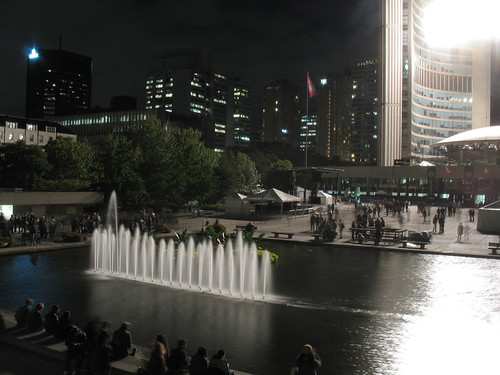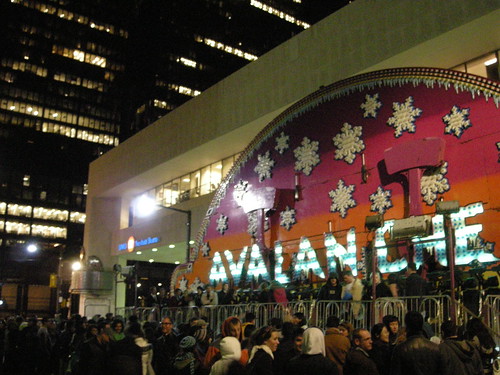
Yes the lines were too long, the streets too crowded, and the TTC too packed. And it’s true that this year, like the years before, the event didn’t seem to live up to its hype and many of the works underwhelmed. But, like almost a million other Torontonions, I spent Saturday night and the early hours of Sunday morning scurrying around the city to experience Nuit Blanche. And I wouldn’t have considered doing anything else.
While all our inner art critics and inner urban planners likely have a laundry list of criticisms about Saturday night, there’s a lot about Nuit Blanche that warrants celebration. Hidden within its flaws there are important lessons for urbanism.
One of the best things about Nuit Blanche is the fact that throughout the night there were thousands of people milling around downtown Toronto. Pedestrians, by their sheer numbers, took over the city’s streets and sidewalks. This reminds us of what a city could be were built for pedestrians. I was struck by this at 2:30 in the morning when I rode my bike past City Hall and saw its benches packed with people. And they weren’t there just to look at D. A. Therrien’s 4-letter word machine. Most people were simply taking a break from the night’s activities. When else but on Nuit Blanche would every bench at Nathan Philips Square be full on chilly night at 2:30 in the morning?

Nuit Blanche gives us a glimpse of what a utopian Toronto might look like. A city where the streets are vibrant, where public space is well used and where pedestrians, rather than cars, rule the city.
It’s not just more people using city spaces that makes Nuit Blanche interesting; it’s the way those people interact with those spaces that’s significant. Public spaces, private spaces and all the grey spaces in between have the potential to be transformed. I spent most of Saturday night in Liberty Village (Zone C) — one of the areas that best demonstrates the transformative effect Nuit Blanche can have. Liberty Village is an area with many parking lots that is often fairly low in pedestrian traffic. But with the streets closed, the area full of exhibits and the dramatic increase in people, existing spaces took on a new life. Parking lots became sites of play and areas of social congregation. Tom Dean’s 10 scattered Fire and Sausage sites (which gave passers-by warm hot chocolate, sausages or blankets) served as focal points and meeting areas. It seemed perfectly natural that hundreds of people were hanging out in parking lots or warming themselves by a fire in the middle of Liberty Street.
This transformation happened throughout the city. Amusement rides on a car-free Bay Street or the transformation of a bus station into a wrestling arena show us how our everyday urban landscape can be used in entirely different ways.

Through Nuit Blanche we see that spaces in the city and their associated functions aren’t static. With ingenuity and energy we can transform our existing urban environments and the way we live in them.
But despite Nuit Blanche’s potential to open up urban space, Saturday night also served to reminded us of how strictly controlled those spaces can be. It’s frustrating that so many of the exhibits had lineups of over half an hour. I waited almost 40 minutes for a chance to crawl under Norico Sunayama’s huge red skirt. I can’t understand why, on a night that is expected to draw almost a million people, some of the most publicized projects could only accommodate about 10 people at a time. Furthermore, this type of exhibit seems to result in the increasing presence of security guards. Security is needed to protect the artists and their work but I wonder why four security guards were necessary to control the traffic flow into Maria Legault’s the Apology Project. Ironically, while Nuit Blanche has the power to allow Torontonians to assert their right to the city, its immense popularity means that it’s becoming increasingly securitized and controlled.
While the promise of the exhibitions may be the initial motivation to participate in Nuit Blanche, I’ve found that the art isn’t the whole reason I look forward to the night. What keeps me coming back is to see how, every first Saturday in October, our experience of the city, its spaces, and the way we relate to them can change.
Photos by Dave Johnson, Jamie Bradburn, and Neal Jennings on flickr




13 comments
I didn’t attend, but it sounds like the article should be entitled “Nuit Blanche: an event changed”. Good that people enjoyed it, the right time of year, good weather, something to try out, but as with all such events, the more popular they become, the more rules apply.
Great vision of what the city won’t be. Toronto is built in too linear a fashion to become a pedestrian city: everything too stretched out on linear shopping streets; few dense retail neighbourhoods with parallel destination streets in close proximity. Only Kensington and Yorkville really meet that criteria: both are small and the former can be visited by unreliable streetcars. It would be nice to have a some dense retail neighbourhoods for other demographics.
Interesting parts of interesting cities like Tokyo’s Shimokitazawa, Asakusa, Akasaka, Omotesando, Harajuku, Ebisu (and many more) are denser and larger than Yorkville or Kensington. If Tokyo can support dozens, you’d think we could have one or two of a decent size.
Well, we could, but our codes would have to let us build new areas in a much denser fashion, and allow property owners to subdivide their lots more freely, including many more ‘alleyway homes’. They day will come, but it will be a ‘a day late and a dollar short’, because that’s how we do things here. I’m not waiting for it. Bye.
“When else but on Nuit Blanche would every bench at Nathan Philips Square be full on chilly night at 2:30 in the morning?”
Probably a rhetorical question, but these beds are actually occupied most nights.
I enjoyed Nuit Blanche, but a bunch of people, including me, were stranded at Exhibition Loop for 2 hours (3am to 5am). There was a power failure on the streetcar line, and for some reason, the TTC didn’t put on a replacement bus, or even send someone down to post a notice or something. I’m struggling to understand how they could possibly consider this to be acceptable customer service, in view of how heavily the 509 was promoted as *the* link from downtown to Liberty Village.
(Eventually we got out on the Bathurst night bus, after an hour-long gap in that service.)
An excellent essay.
It mystifies me how the TTC could provide such poor service on Saturday night….even while it was still regular operating hours! On King streetcar there were no streetcars. Hundreds of cabs went by in that time.
I wondered why a concert hall that holds thousands could only accommodate a few people at a time. I wondered why the Eaton Centre locked its west door so you could not walk the 50 yards across it. I wondered why Security Guards felt they needed to stand in the middle of the ghost mumblers.
Still, I love Nuit Blanche and I hope the organizers learn from these lessons.
“Nuit Blanche gives us a glimpse of what a utopian Toronto might look like. A city where the streets are vibrant, where public space is well used and where pedestrians, rather than cars, rule the city”
Sorry Kat, (and sorry to everyone, I hate being a downer), but Liberty Village must have been MUCH nicer than the rest of the city (I didn’t make it that far before being too discouraged – I should have kept going), because Bay/Queen was NOT utopia. People shoving, drinking, puking. The street was vibrant, just not in any sort of positive way.
I must say, that the “Hey Dave” project was a great idea, despite its small scale.
A comment about an event he was half a world away from.
So long, jamesmallon!
jamesmallon: Why don’t we ask the USAF to raze Toronto to the ground so we can start over from scratch? It worked for Toyko.
Tokyo! Whoops!
I’m impressed with the way Torontonians see the potential in NuitBlanche despite the areas for improvement that remain. Almost everyone wants it to work so very much.
Speaking of almost everyone, jamesmellon…Toronto will never be a great city because it’s too linear!?! You must yell at flowers and puppies in your spare time.
Re: the TTC, North of Eglinton, the TTC was running it’s usual night service, and half the buses turned back at York Mills. Queues for the bus were apparently completely insane at Eglinton. It would be interesting to see how much the experience could be improved if the TTC provided service that matched the anticipated crowds.
To those who complained about the unruliness of a few people or the crowds I think you need to accept that that is what you will get when you have a mass even of that scale. Out of a million people you are sure to get a certain portion that are gonna be intoxicated. Having lived on both sides of the Atlantic, I can say that every European city worth it’s salt has an event of this type at least once a year and just as here there can be drunken idiots. I think the cost of having those idiots (who are certainly not the majority) is outweighed by the benefit of an event that, at it’s heart, is a great way of building a sense of community, of togetherness, of Toronto. Whatever you think of the art, really it has become secondary to the party, the festiveness, the carnival atmosphere (brilliantly embodied by Bay St). What it comes down to is that we need an excuse. An excuse to congregate and mingle irrespective of class or ethnicity or anything. Whether that excuse is art or music or film I think it is worthwhile. Purists may disagree. That is fine.
TTC service has been a complaint of Nuit Blanche for three years running now. And each subsequent year they have made incremental improvements in service, but have been behind the curve it seems in all cases.
Here’s something that would be worth a look: don’t just run a little more service than you would normally run overnight. Pick some of the routes that serve the three areas particularly well, and go all out. Hell, people are saying it attracted a million people, but from all accounts of the TTC service, you would never know it. Run five-minute frequencies on the Harbourfront LRT, if you are promoting that as the way to get to Liberty Village. Run five-minute frequencies on Spadina, and the core part of the King or Queen streetcars. Run five-minute frequencies on the key north-south routes connecting exhibits to the subway… run five-minute service on the subway! That would make it a lot easier to travel between the three zones … plus in a geeky way I think it would add to the atmosphere — for one night Toronto is the city that doesn’t sleep, including the TTC.
Luke: Are they still? I’m pretty sure they’re now vacant thanks to Miller making it illegal for people to sleep on those benches at night.
It’s not just the spaces that change during Nuit Blanche, but the people who occupy those spaces and the rights afforded to people occupying those spaces…